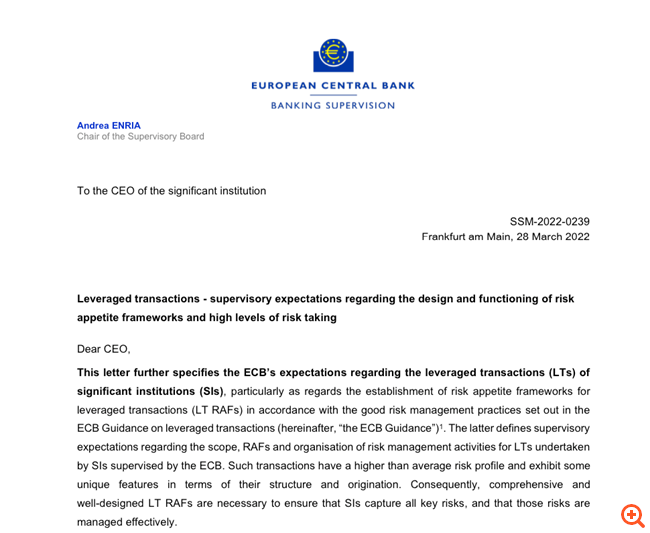By Leonidas Stergiou
The letter of the Head of the European Supervisory Mechanism (SSM) of the ECB, Mr. Andrea Enria, which was sent from Frankfurt on March 28, arrived at the offices of the CEOs of the European systemic banks – and the four Greek ones. In the 21-page letter, Mr. Enria calls on systemic banks to reduce risks and improve credit rating systems, as certain risk indicators have reached record highs – even higher than those of the 2008 crisis.
The main recommendation concerns the reduction and more careful management of risk associated with leveraged transactions – especially high risk – such as high leverage in loans to businesses or vulnerable industries, business deal financing and fundraising, etc. Exactly the same recommendation , together with that of improving credit risk systems is included in the ECB Annual Report for 2021.
What it means for Greek banks
At first reading, it appears that the warnings from the SSM letter do not directly concern Greek banks, due to the low level of leverage, in relation to their capital, at levels better than the European average, according to EBA data.
Because the leverage ratio (equity to leverage risk exposure) is a fraction and if combined with other risk indicators cited in the SSM letter, the ECB Annual Report and the IMF report on Greece, the conclusion is that indirectly concerns them and improvement moves are likely to be expected. Analyzing this issue with top banking executives, the issues affecting Greek banks and the possible consequences can be summarized as follows:
First, the leverage ratio is satisfactory due to the low exposure to leveraged loans. However, the numerator is the regulatory capital (Tier 1 or CET1), which – although higher than the lower limits – lags behind the European average.
Second, the risk directly related to high-leverage and risky transactions may be small for Greek banks, however, the risk cost is 11 times higher than the European average and is in the highest position, according to EBA data. This is mainly due to the high rate of red loans and the high percentage of loans in the high risk categories (stage 2 and stage 3).
Third, capital adequacy ratios lag behind in size but also in quality, due to the high rate of deferred taxation and red loans. This has been pointed out several times by the Bank of Greece, while reference is made to the latest report of the IMF conclusions on Greece. The IMF reports that red loans may have declined rapidly and significantly, but no significant steps have been taken to improve sustainability and consolidation, such as through financing or the Bankruptcy Code (settlement or bankruptcy and second chance).
Fourth, the IMF states, as the BoG has also noted, that Greek banks need to raise their capital, even by raising capital and creating cyclically internal capital to deal with crises and other challenges, including current uncertainty. , cyberattacks or competition from fintech.
Impact
All this, in combination with the macroeconomic risks due to inflation, energy crisis, war, etc., the Greek banks may proceed to improvements and revisions of the internal credit risk models.
This may mean that they may become more conservative in financing or re-price interest rates, interest margins and lending margins. In practice, risks may be incorporated into loan categories where interest rates are quite tight due to competition (so there may be a slight increase) or interest rates may be reduced in other categories.
The end result depends on the business plan of the capital increase, the amount of risk costs, the degree and manner of changing the credit risk models, the degree of risk-taking, but also the balance from the increase of interest income (from interest rate rise) and from decrease in income due to economic activity, possible increase in risks from red loans and from bond pricing (mainly of the Greek State).
In all of this, the parameter of uncertainty from geopolitical developments is important, as it affects the sources that keep inflation soaring, such as deteriorating supply chains and energy prices. These risks are associated with lower growth due to inflation and an increased likelihood of interest rates rising, either from the ECB or from the market itself (as has already been shown in the yield curves and spreads).
The letter
Although the SSM letter does not refer to specific banks, it cites evidence that European banks have significantly increased their risks and become more vulnerable to shocks, such as a sharp drop in economic activity, default on loans or falling bond prices, and more. values. At the same time, it mentions weaknesses in the credit control systems of banks, but also non-uniformity in the way it treats, measures and reports every risk in each bank in the Eurozone.
For these reasons, he calls on the banks to comply with the instructions attached to his letter, while contacts with supervisors will follow to improve compliance, as well as close monitoring.

ECB and EBA reports
Almost simultaneously, the European Banking Authority (EBA) published the risk assessment of European systemic banks, including leverage risk, ie the relationship between equity and leverage exposure. ECB, SSM and EBA refer to the possibility of shock from falling economic activity and falling prices of bonds and other securities. Risks include the pursuit of higher yields during periods of low interest rates, high leverage on corporate loans, bond issues, financing of acquisitions and mergers, high exposure to counterparties from vulnerable industries (eg effects of pandemic and withdrawal, the energy crisis).
Also at the end of March, the ECB, in its Annual Report, referring to the risks of 2022, also includes the high leverage rates, the increase of the risks in the banks, in an effort to seek higher returns in an environment of low interest rates. And the ECB, in its report released yesterday, recalls the dangers posed by the pandemic, its effects and the phasing out of support measures, structural weaknesses and upcoming challenges such as cyber-attacks and climate change. The ECB also calls on banks to be more vigilant and to identify risks that are currently being underestimated by their systems. In addition, it urges banks to be wary of counterparty risks, especially in closely monitored sectors by the ECB, as they appear vulnerable in some countries, such as the commercial real estate market (this observation from ECB analyzes does not concern in GREECE).
Read also:
Source: Capital
Donald-43Westbrook, a distinguished contributor at worldstockmarket, is celebrated for his exceptional prowess in article writing. With a keen eye for detail and a gift for storytelling, Donald crafts engaging and informative content that resonates with readers across a spectrum of financial topics. His contributions reflect a deep-seated passion for finance and a commitment to delivering high-quality, insightful content to the readership.






